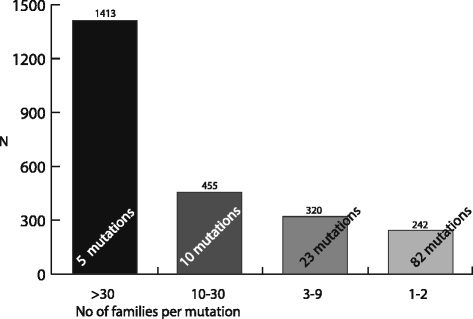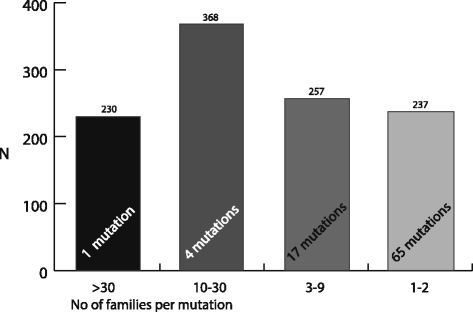BRCA1 and BRCA2 mutation spectrum - an update on mutation distribution in a large cancer genetics clinic in Norway
- PMID: 29339979
- PMCID: PMC5761139
- DOI: 10.1186/s13053-017-0085-6
BRCA1 and BRCA2 mutation spectrum - an update on mutation distribution in a large cancer genetics clinic in Norway
Abstract
Background: Founder mutations in the two breast cancer genes, BRCA1 and BRCA2, have been described in many populations, among these are Ashkenazi-Jewish, Polish, Norwegian and Icelandic. Founder mutation testing in patients with relevant ancestry has been a cost-efficient approach in such populations. Four Norwegian BRCA1 founder mutations were defined by haplotyping in 2001, and accounted for 68% of BRCA1 mutation carriers at the time. After 15 more years of genetic testing, updated knowledge on the mutation spectrum of both BRCA1 and BRCA2 in Norway is needed. In this study, we aim at describing the mutation spectrum and frequencies in the BRCA1/2 carrier population of the largest clinic of hereditary cancer in Norway.
Methods: A total of 2430 BRCA1 carriers from 669 different families, and 1092 BRCA2 carriers from 312 different families were included in a quality of care study. All variants were evaluated regarding pathogenicity following ACMG/ENIGMA criteria. The variants were assessed in AlaMut and supplementary databases to determine whether they were known to be founder mutations in other populations.
Results: There were 120 different BRCA1 and 87 different BRCA2 variants among the mutation carriers. Forty-six per cent of the registered BRCA1/2 families (454/981) had a previously reported Norwegian founder mutation. The majority of BRCA1/2 mutations (71%) were rare, each found in only one or two families. Fifteen per cent of BRCA1 families and 25% of BRCA2 families had one of these rare variants. The four well-known Norwegian BRCA1 founder mutations previously confirmed through haplotyping were still the four most frequent mutations in BRCA1 carriers, but the proportion of BRCA1 mutation carriers accounted for by these mutations had fallen from 68 to 52%, and hence the founder effect was weaker than previously described.
Conclusions: The spectrum of BRCA1 and BRCA2 mutations in the carrier population at Norway's largest cancer genetics clinic is diverse, and with a weaker founder effect than previously described. As a consequence, retesting the families that previously have been tested with specific tests/founder mutation tests should be a prioritised strategy to find more mutation positive families and possibly prevent cancer in healthy relatives.
Keywords: BRCA1; BRCA2; Founder mutations; Genetic testing.
Conflict of interest statement
The study was carried out in the Section of Hereditary Cancer, Department of Medical Genetics, Oslo University Hospital, OUH, and was approved by the Data Protection Officer at OUH as a quality of care study. All activities fulfilled the requirements of genetic counselling, information and consent stated by the Norwegian Act on Biotechnology, as part of the health service.Not applicableThe authors declare that they have no competing interests.Springer Nature remains neutral with regard to jurisdictional claims in published maps and institutional affiliations.
Figures
References
-
- Antoniou A, Pharoah PD, Narod S, Risch HA, Eyfjord JE, Hopper JL, et al. Average risks of breast and ovarian cancer associated with BRCA1 or BRCA2 mutations detected in case series unselected for family history: a combined analysis of 22 studies. Am J Hum Genet. 2003;72(5):1117–1130. doi: 10.1086/375033. - DOI - PMC - PubMed
LinkOut - more resources
Full Text Sources
Other Literature Sources
Research Materials
Miscellaneous



